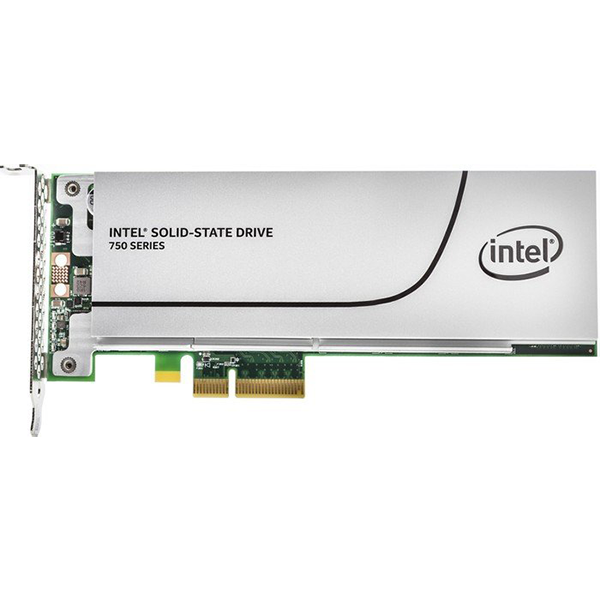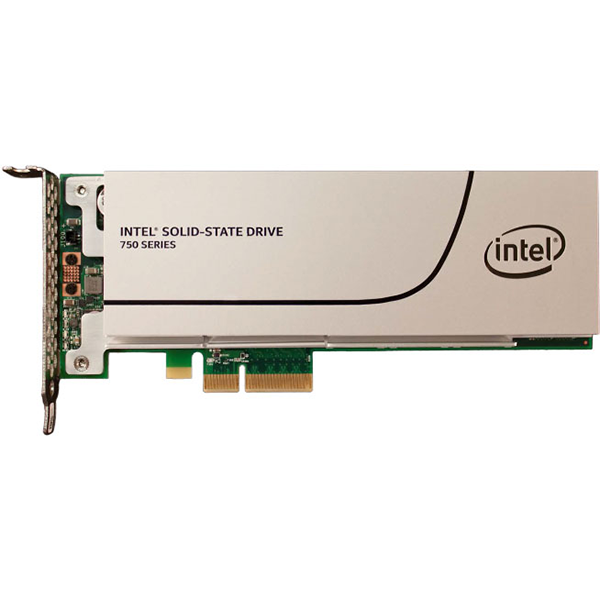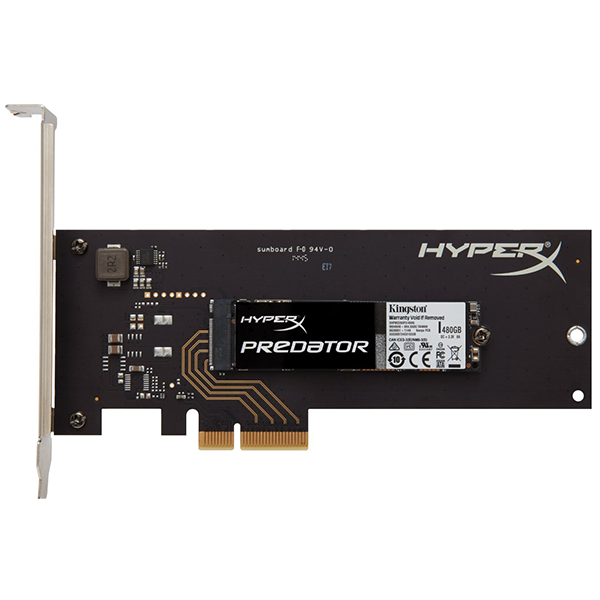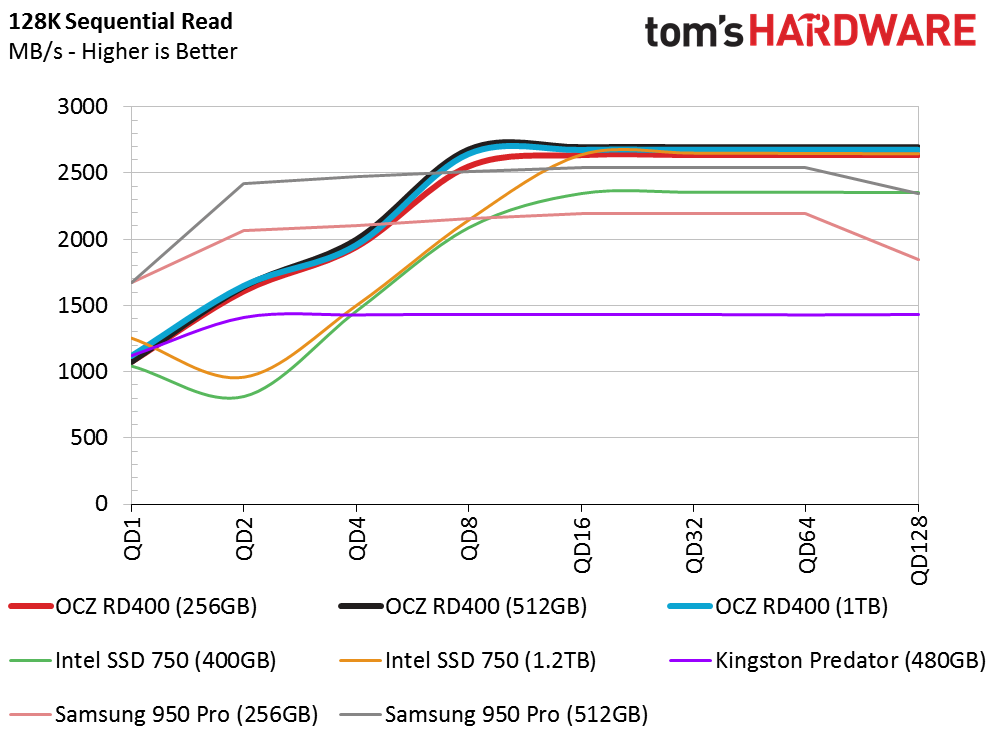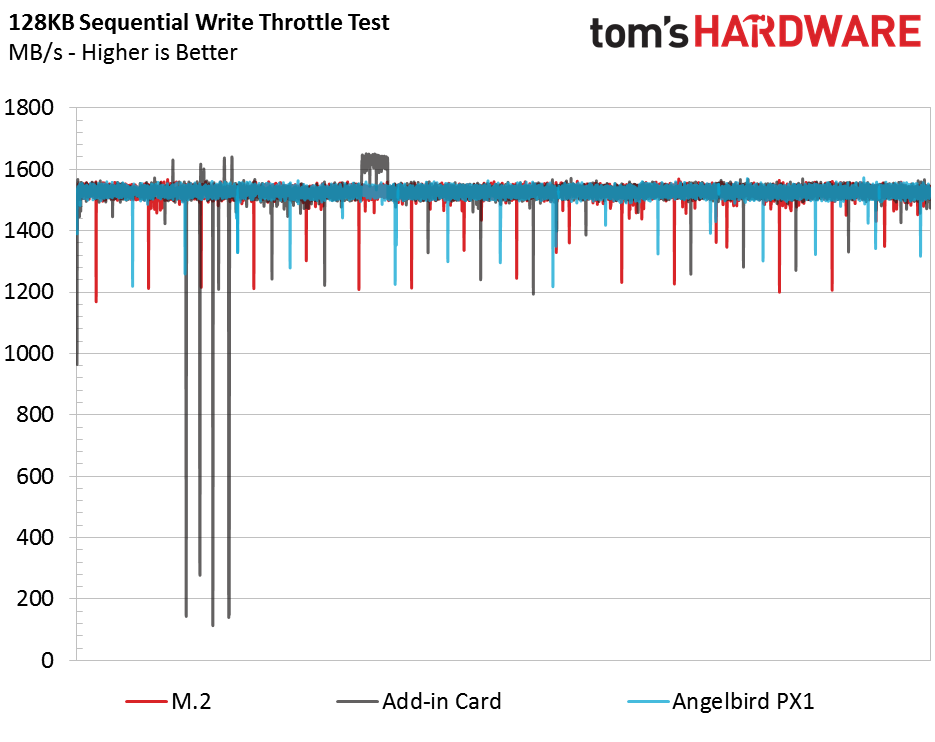OCZ RD400 NVMe SSD Review
Why you can trust Tom's Hardware
Four-Corner Performance Testing
Comparison Products
NVMe was quickly adopted in the enterprise SSD space but manufacturers have been slow to adapt the technology for client use. There are only three retail NVMe products currently shipping: the Samsung 950 Pro, Intel SSD 750 and the Zotac SONIX. The SONIX SSD is not in our comparison charts today, as its Phison E7 NVMe controller will receive a new firmware update in the coming days that increases performance.
We included the largest and smallest capacity Intel SSD 750 NVMe Add-In Card (AIC) SSDs in the tests. You can read about the mid-range 800GB drive here.
The OCZ RD400 is a direct competitor to the Samsung 950 Pro. Both drives feature the M.2 form factor and operate in desktops and high-performance notebooks. We included both existing 950 Pro capacity sizes, and Samsung relayed to media that a larger 1TB 950 Pro would emerge in early 2016. The product has yet to launch.
We also included the 480GB Kingston Predator in the tests. The Predator employs a Marvell PCIe 2.0 x4 flash controller and serves as a representative of previous generation M.2 SSDs that utilize the AHCI protocol.
To read about our storage tests in-depth, please check out How We Test HDDs And SSDs. Four-corner testing is covered on page six of our How We Test guide.
Sequential Read Performance
The OCZ RD400 aims for the consumer and workstation markets, and your workload dictates how far up the queue depth range you should focus. Regular desktop and notebook users should focus on very low queue depths, between 1 and 4, and workstation users should look slightly higher, between 2 and 8.
All three OCZ RD400 SSDs deliver very good low queue depth sequential read performance. The RD400 provides slightly more bandwidth than the Intel SSD 750 products, but less than Samsung's 950 Pro. Operating system and software limitations serve to level out performance between the products because the software has not evolved enough to take advantage of the available performance during many common workloads. We will look at real-world application performance later in the review, which will highlight how much the legacy software limits bandwidth.
Get Tom's Hardware's best news and in-depth reviews, straight to your inbox.
Sequential Write Performance
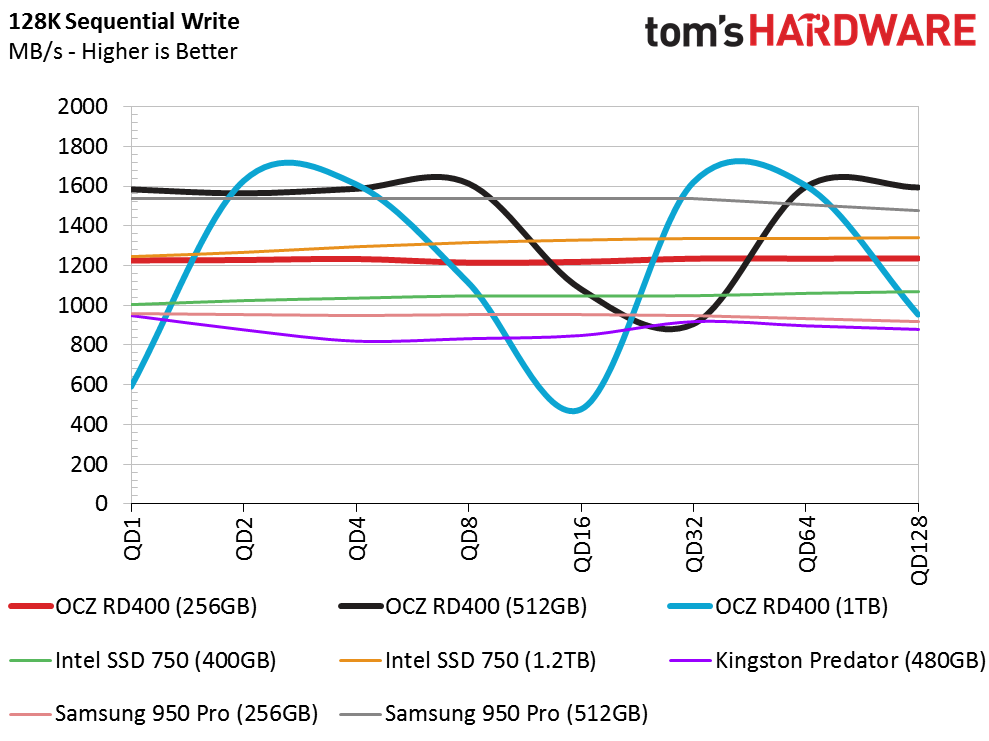
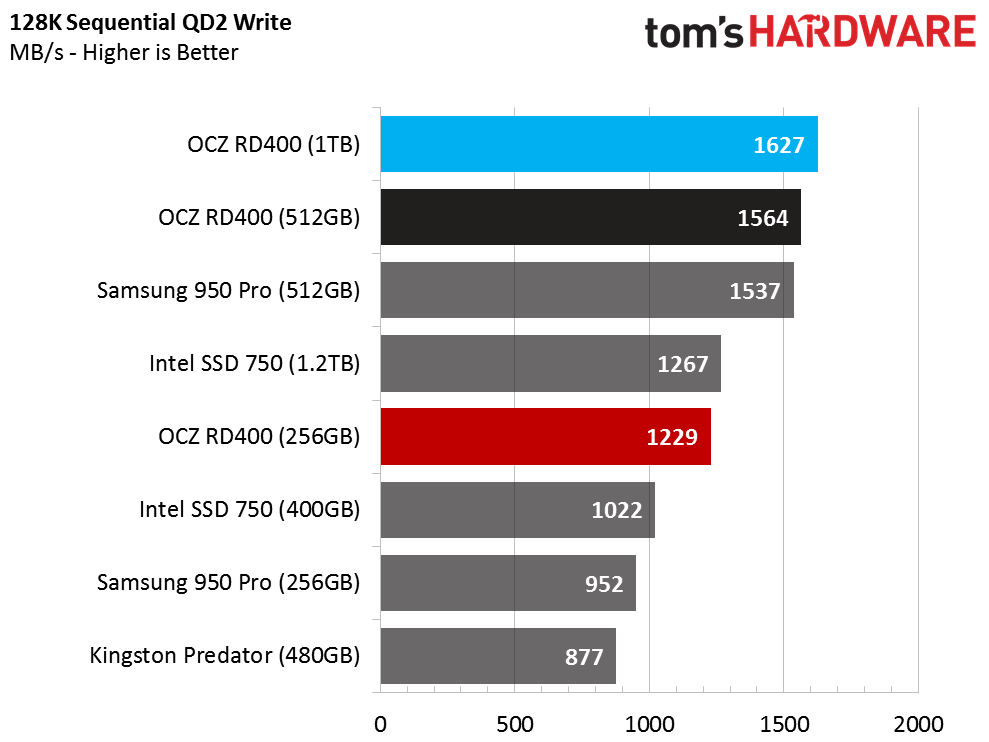
The two largest RD400 SSDs feature a “wavy” performance profile during the test, which is what we would normally expect during thermal throttling. We tested the drives without the add-in card adapter, which adds a small heat-absorbing element. The results would lead you to believe the RD400 has a throttling issue, but that is not the case. We will cover that in more detail in the next section.
The two largest RD400 SSDs (512GB and 1TB) deliver the highest sequential write performance of any consumer SSD we have tested. The 256GB RD400 trails slightly behind its bigger brothers, but matches the sequential write performance of the 1.2TB Intel SSD 750. It also outperforms the lower capacity 750 and 950 Pro.
Sequential Thermal Throttle Test
It is important to understand how we drove the SSD into the thermal throttle condition. We automated our synthetic SSD tests so they can run back-to-back. The intense tests take more than three hours to complete, which is not a realistic timespan for a typical client workload, especially if we are attempting to identify thermal throttling during normal use. In addition, the random workloads occur prior to the sequential workload, and we did not observe a throttling condition during the random portion of the test regimen.
In the chart above, we tested the RD400 1TB in three configurations to look for signs of thermal throttling. The first test (red line) is the M.2 drive without any thermal transfer material. The second test (gray line) utilizes the OCZ add-in card with thermal transfer material between the card and the RD400. The third test (blue line) utilizes an Angelbird Wings PX1 M.2 to PCIe adapter, which features a large half-height, half-length heatsink.
The preconditioning phase of the test is just as important as the end result. We filled the drive with data, and then let it rest for a half hour to normalize the controller temperature. We ran Iometer with 100% sequential 128 KB writes for two hours after the idle period, recording performance every second.
Only the base M.2 should exhibit throttling issues during the two-hour workload, but it does not have a throttling issue. The add-in card experienced a few significant performance dips, but only for a brief time. I believe the dips stem from internal wear leveling or other background activity, and are not the result of a throttling issue. The Angelbird Wings PX1 adapter test should display the least amount of variation due to its large heatsink, which is in direct contact with the controller. However, the PX1 results show the same variation as the base M.2 test.
The tests only indicate that thermal throttling is not an issue with very large sequential write workloads. It does not mean a user cannot force a throttle condition with small-block random write data. Random writes take place in very short bursts under typical conditions. An extended random write workload is so far outside of the RD400’s design parameters (and typical workloads) that we are not concerned enough to test it.
Random Read Performance

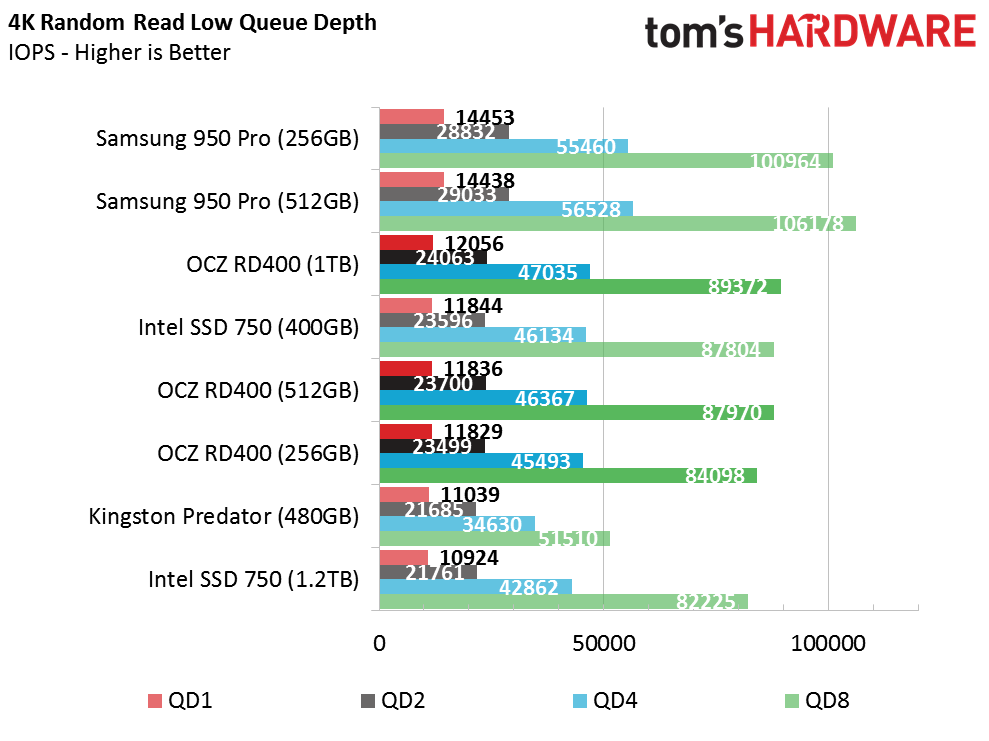
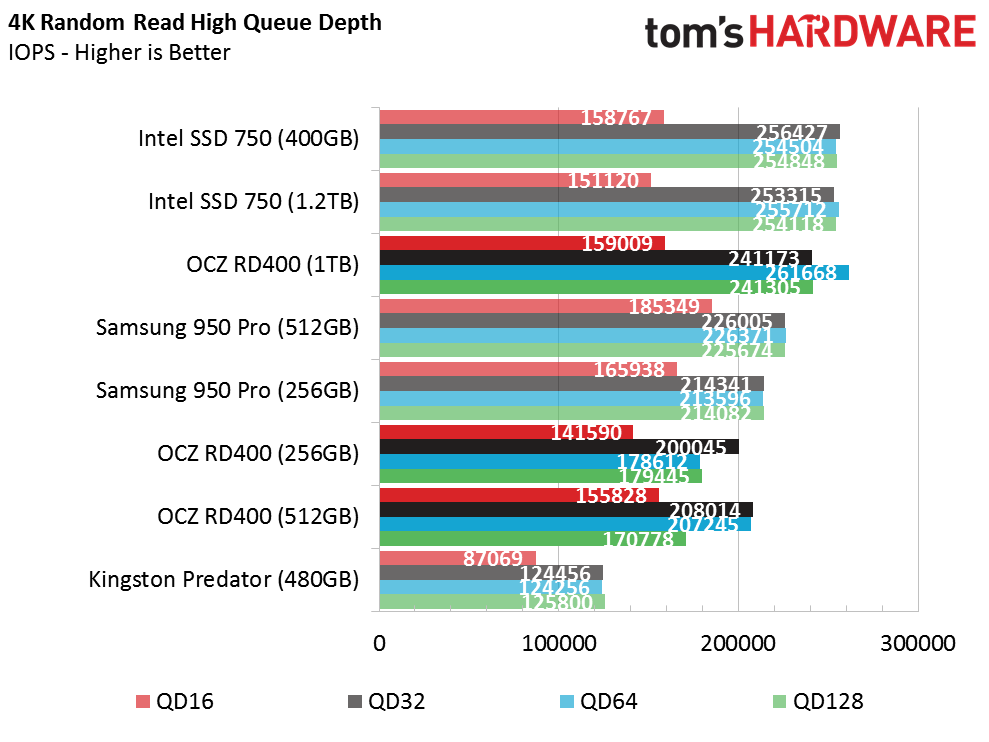
We analyze random small-block size performance at a queue depth of 1 to separate mainstream products from high performance models, and all of the SSDs on the chart are premium SSDs. 10,000 random read IOPS is the normal crossover point between high-performance and mainstream products, and all of the SSDs in our test surpass that mark.
The OCZ RD400 products trail the Samsung 950 Pro at low queue depths, but the performance difference is very small. All three of the OCZ drives scale well up to queue depth 64. We see a slight decline at queue depth 128, but your workload will never reach that peak for it to become a performance issue.
Random Write Performance
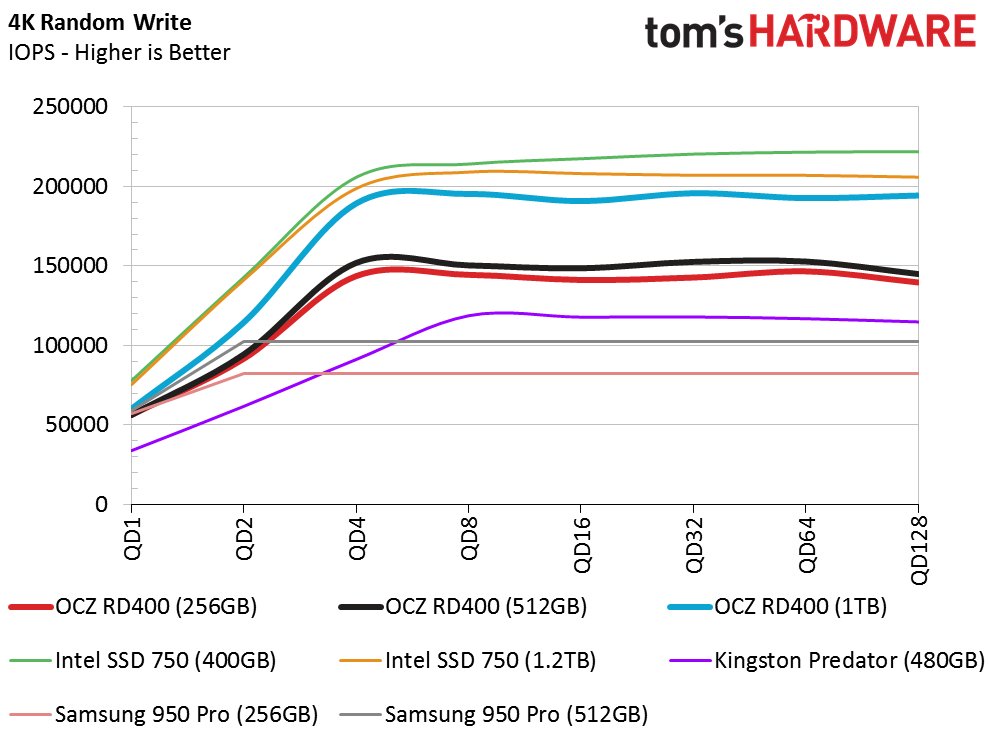
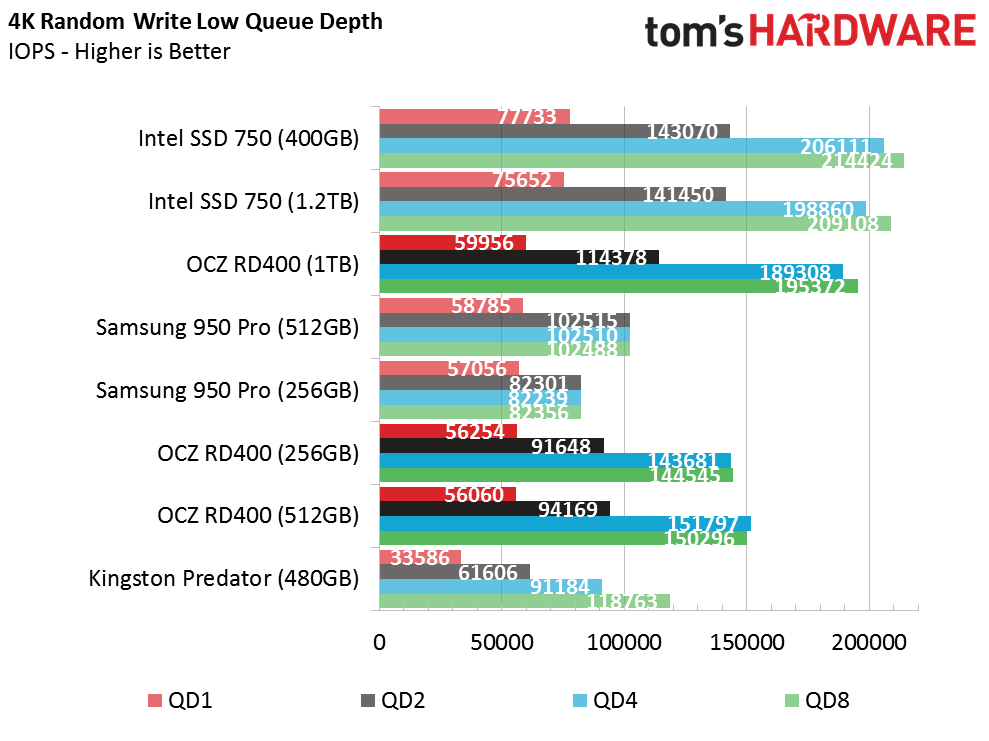
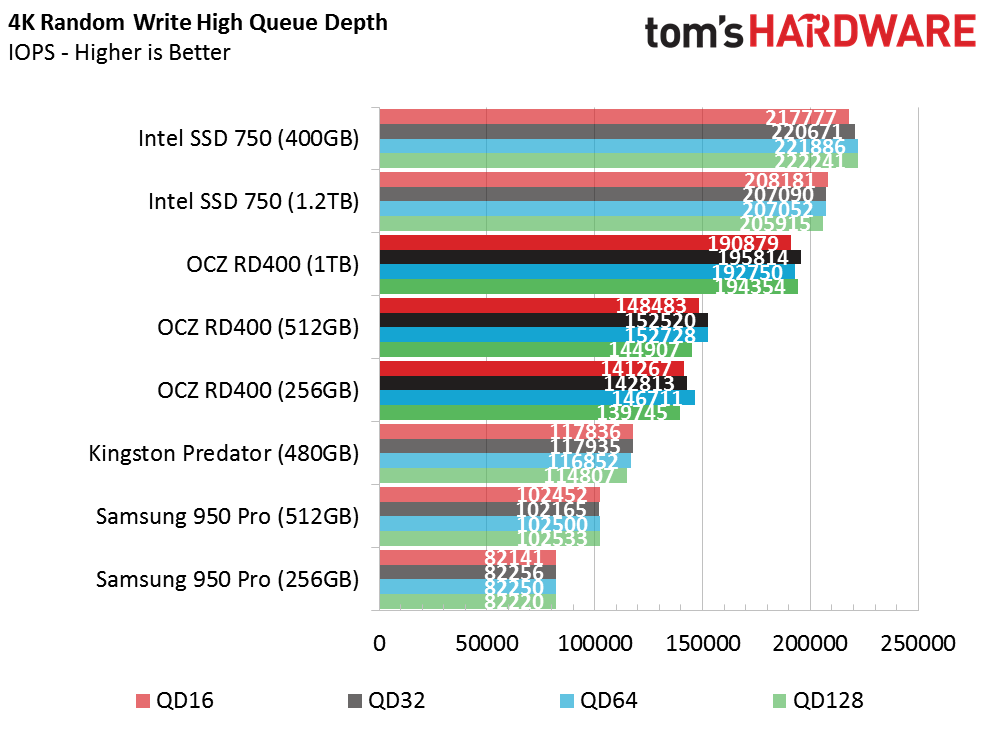
The Intel SSD 750 has a low queue depth advantage with small-block random write workloads over the Samsung 950 Pro. The advantage stems from the power limitations of M.2 compared to a discrete add-in card form factor; PCIe cards have a higher power budget than M.2 SSDs. The M.2 power specification limit is around 8 watts, whereas the PCIe add-in card limit is 25 watts.
The OCZ RD400 SSDs fall in between the two existing NVMe products during random write measurements. I never expected to see a true M.2 SSD reach the high peak random write numbers that the RD400 1TB achieved at queue depth 4 with the current power limitations. The two small capacity RD400 SSDs also set new records for consumer M.2 performance.
High random write performance reduces system latency and increases the user experience. The OCZ RD400 provides the superior low latency feel you want, but does so with very low power consumption.
Current page: Four-Corner Performance Testing
Prev Page A Closer Look Next Page Mixed Workloads And Steady State
Chris Ramseyer was a senior contributing editor for Tom's Hardware. He tested and reviewed consumer storage.
-
2Be_or_Not2Be I believe Toshiba should just kill the OCZ brand name. As the author mentions, a lot of people have bad reactions to OCZ products. For every user who had good memories, there are at least 3-4 others who don't. So make a clean break - kill the OCZ brand name & either create a new one or just use Toshiba.Reply -
CaedenV ReplyI believe Toshiba should just kill the OCZ brand name. As the author mentions, a lot of people have bad reactions to OCZ products. For every user who had good memories, there are at least 3-4 others who don't. So make a clean break - kill the OCZ brand name & either create a new one or just use Toshiba.
I mean... have you ever used a Toshiba laptop? You think people have bad memories of OCZ! At least the OCZ issues only poisoned the cheap enthusiast market. Toshiba's own bad name is far more broad reaching. -
CaedenV My own expierence with OCZ was hit and miss. Their great products were fantastic and cheap, while their crap was really truly crap. 3-4 years ago when I was upgrading to SSDs I bought all OCZ products simple because there was nothing else that was affordable at the time. A lot of their gen2 products were pretty scarry, but their 3rd gen Agility lineup was pretty reliable, and came in much MUCH cheaper than anyone else. I had a Solid 2 and Agility 2 that died on me, which were replaced by an Agility 3 and Vertex 3 (both under warranty). So my expierence was not too terrible.Reply
But then again, you get what you pay for. Any time a new tech comes in that much cheaper than the competition you have to expect failures.
Not to mention, some of their PSUs were fantastic! After they bought PC Power & Cooling you could get essentially a PCnP PSU for $50 less as an OCZ rebrand! I have a 750W 80+Silver OCZ rebrand and it has been running 24/7 for almost 5 years without so much as a hiccup! Granted, their in-house OCZ PSUs were crap... but that's why you do a bit of research before buying. -
2Be_or_Not2Be ReplyI believe Toshiba should just kill the OCZ brand name. As the author mentions, a lot of people have bad reactions to OCZ products. For every user who had good memories, there are at least 3-4 others who don't. So make a clean break - kill the OCZ brand name & either create a new one or just use Toshiba.
I mean... have you ever used a Toshiba laptop? You think people have bad memories of OCZ! At least the OCZ issues only poisoned the cheap enthusiast market. Toshiba's own bad name is far more broad reaching.
So you're saying you would go for the new brand name option. ;)
Actually, I have used several Satellite Pro laptops back in the day; they weren't too bad. Even you really want to go back, I've used Toshiba FDDs (floppy disk drives) w/no problems. I also have a number of Toshiba enterprise drives, both HDD and SSD. So I guess for me, Toshiba has much better brand equity in my mind than OCZ. -
erendofe the only thing I bought of OCZ was a 2 power supplies (700W)... I guess its kinda hard to completely screw them up because both work great. must be luckyReply -
3ogdy "We, and other sites, notice the proliferation of negativity about OCZ in the comments section of every OCZ news post or product review. Undoubtedly, even before reading beyond this point, some are already reaching for their keyboards to pen a chilling tale of a poor product, support or warranty issue.Reply
In the past, OCZ would flaunt a prototype fresh off the production line at a trade show and we would see retail products within a few months. Times have changed and OCZ is now part of Toshiba, which is renowned for its extensive testing, longer development cycles and true tier 1 status."
I'm glad people like you are aware of this. I'm sad people like OCZ might not be. Well, after how successful they ended up being (/irony) they probably know it too.
How about making this cursed name disappear from the market? It just doesn't matter if Toshiba, Samsung, Microsoft, Bill Gates the man himself, God or an alien aliance bought OCZ. We all remember how they treated their customers and how disastrous their products were. I'm gonna stop talking about it here because you ALL know what's up with OCZ. Toshiba, be smart about it...get rid of that name.
It seems very strange that they decided to put their tech under that crappy brand's hood and market those when they already knew what the problem was. Buying one of those products was like buying a lottery ticket.
Dog gamn, even dictionaries from the Roman era had taken notice of this lousy company's products before they went downhil. I'm surprised there are no comments on how OCZ would destroy their own products through the release of updates that bricked their customers' drives for free? (do I see a pattern here? Oh...right, it's OCZ) l:
-
crenwelge I got great customer service out of OCZ, they promptly replaced an SSD for me that I mistakenly thought was bad. Turns out, the problem was with my Asrock hardware. Asrock is either the stupidest or most dishonest company I've ever dealt with. After 5 RMA's I finally gave up on Asrock. I diagnosed and paid for a replacement out of my own pocket.Reply -
Virtual_Singularity The listed numbers look promising for the RD400, no doubt. It may be worth noting that of the top 3 performers we see in the charts, only Samsung at least offers a basic level of data security via their AES 256-bit for User Data Encryption. I thought Intel's 750 series would surely at least include the same, and was a tad surprised to find out they don't.Reply -
LordConrad I have two Vertex 2 drives and one Vertex 3, and never had any problems with them.Reply
I prefer Samsung drives these days because of the V-NAND endurance but the RD400 is a good drive, I would buy one if the price was right.
